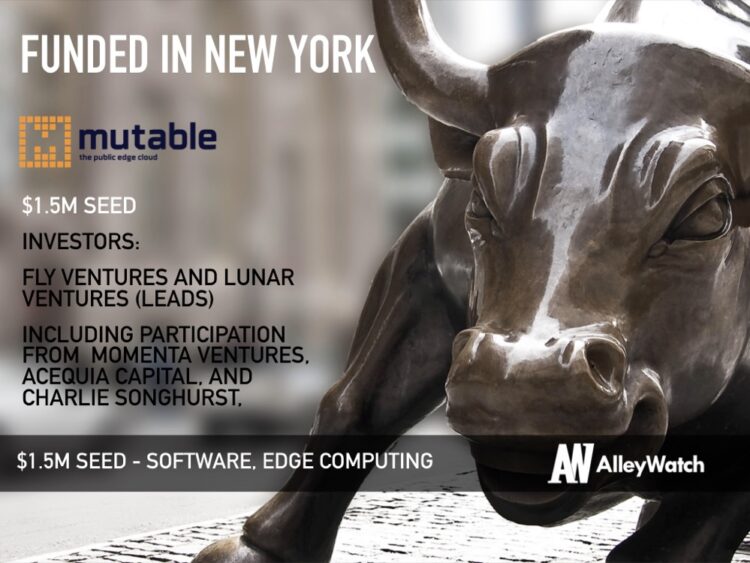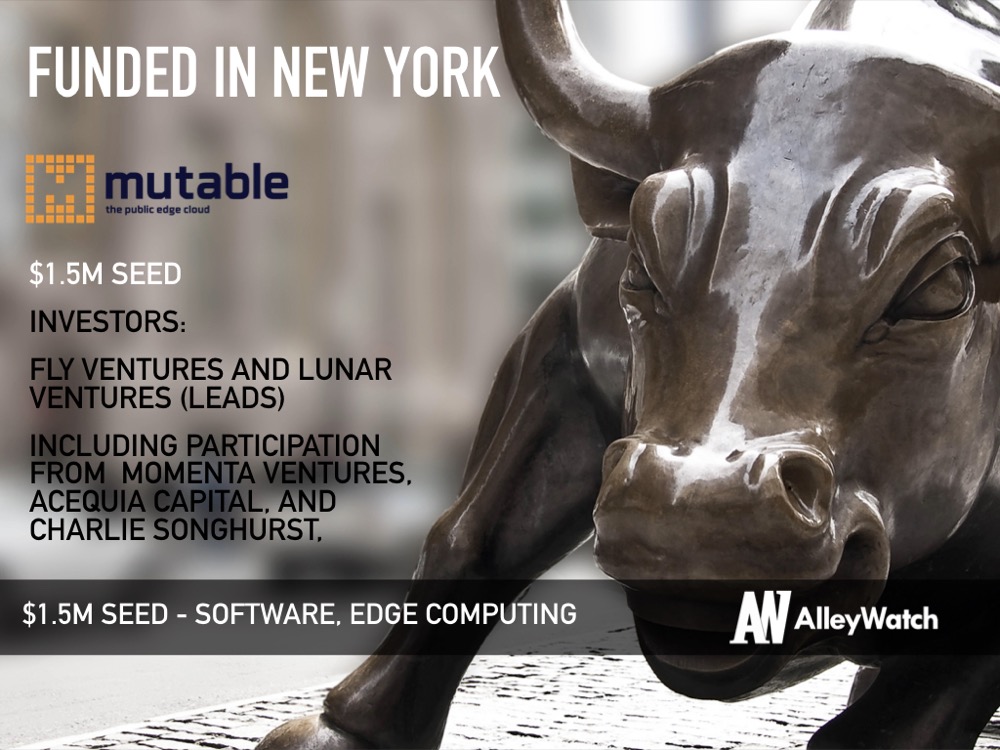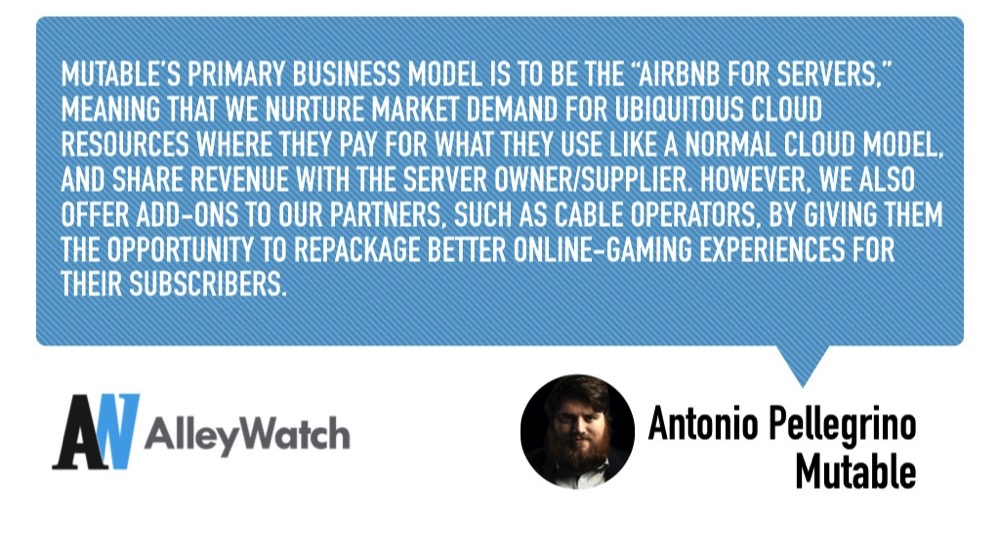Wearable devices like Smartwatches or AR/VR mobile apps are posed with the same problem – high latency and on-device compute, which translates into shorter battery life, high cost of hardware and maintenance fees, and limited processing. Edge computing companies like Mutable change that. Mutable’s Public Edge Cloud delivers a higher quality internet experience that is faster, cheaper, greener, and more sustainable. Mutable also offers a marketplace for server operators (primarily telecom companies) to rent out underutilized server space to developers targeting latency-sensitivity and high bandwidth applications; earning ancillary revenue in the process from assets that are not being used. Mutable’s OS allows this to happen seamlessly as it sits on top of any server; avoiding any integration conflicts.
AlleyWatch interviewed Antonio Pellegrino to learn more about Mutable’s business and its recent funding round.
Who were your investors and how much did you raise?
We raised a $1.5M Seed round from a consortium of US and European investors led by Fly Ventures and Lunar Ventures and including Momenta Ventures, Acequia Capital, and Charlie Songhurst.
Tell us about the product or service that Mutable offers.
Mutable is developing a Public Edge Cloud that delivers a faster, cheaper, greener and more secure internet experience. To achieve this, we help computing resource operators (often in the cable and telecom industry or enterprises operating their own servers) “rent out” those extra compute resources from underutilized server space to developers looking to target latency-sensitive, high bandwidth and to security services for deploying services before reaching the internet. It’s very similar to the way Airbnb offers an extra revenue source for underused property owners by offering the property to people looking for short-term accommodation.
 What inspired the start of Mutable?
What inspired the start of Mutable?
Since before I can remember, my cofounder Nathalie Zadoks (“Edef”) and I shared an interest in designing and building networks. From my side, it was a natural progression from my gaming years. I went from wanting to play online to eventually starting my own company that offered esports streaming, and later, building developer tools. By 2017, I realized that 5G networks made it possible to utilize my previous company’s underlying technology to create a hyper-low latency cloud. That’s how Mutable was born.
How is Mutable different?
While large data center operators like AWS, Microsoft Azure, and Google Cloud are just now understanding the potential of deploying on the Edge, by building our software infrastructure from scratch, we have the unique ability to build scalable and infinitely adaptable solutions for each one of our clients’ needs rather than a “one size fits all” solution like bigger players offer.
Unlike private cloud service providers like Openstack and Redhat, we create new sources of revenue for server owners by opening up their compute to third party developers. Since Mutable’s OS runs on top of any server, we make ubiquitous computing easily available for developers, while also empowering telcos and cable operators to improve their customer experiences.
What market does Mutable target and how big is it?
At the moment, Mutable’s target market is North American cable operators, who have the compute resources and are seeking new ways to monetize them while providing additional services to their customers. However, the market can quickly be extended to telcos – cable operators across the world on the one hand, and any developers in need of extra compute without the jitter and latency issues on the other.
Who do you consider to be your primary competitors?
Competitors include VMware, Microsoft Edge Zones, Red Hat, AWS Wavelength, Openstack, and hyperscalers in general.
What’s your business model?
Mutable’s primary business model is to be the “Airbnb for Servers,” meaning that we nurture market demand for ubiquitous cloud resources where they pay for what they use like a normal cloud model, and share revenue with the server owner/supplier. However, we also offer add-ons to our partners, such as cable operators, by giving them the opportunity to repackage better online-gaming experiences for their subscribers.
What was the funding process like?
Raising seed funding was definitely a learning experience for us. It required understanding and balancing the nuances in the unique approaches that venture capital firms, across different continents, use when investing in startups. For example, different regions have various approaches to risk tolerance and how far out they are looking in terms of vision married with their technical know-how. However, in general, it’s been a great experience, and our investors have shown themselves to be extremely supportive of our vision.
What are the biggest challenges that you faced while raising capital?
Educating the investors about the market opportunity. It is always harder to convince an investor when the answer to who else is doing this is ‘no one.’ I typically plan and see things a bit further out and to find an investor that can take that journey with us was a challenge, but having the market show more markers that we are on the right track was key.
What factors about your business led your investors to write the check?
The technology. Our investors were quickly able to both grasp how “out-of-the-box” our solution was to the issue of compute resource availability on the edge, and they believe in our vision for the future of cloud computing being on the edge. It was just a matter of time until we convinced enough investors that we were planning on the long term, and they wanted to be on that journey with us.
What are the milestones you plan to achieve in the next six months?
Right now, we’re focusing on launching our latest product: Mutable Marketplace. The Marketplace is designed to offer exposure for edge vendors whose solutions are compatible with our Mutable Cloud software and allow them to roll out demos directly on our platform for operators or other telcos. The product is currently released in beta, but we intend to release the final iteration in June.
The other focus right now is growing our team. Part of the funds has already been allocated to expanding our product and business development teams (in order to better educate the public about edge computing). We also plan to roll out pilot projects with our partners in the cable industry. We will prove our business model with our already started pilots, related to gaming, latency, revenue generation for server owners, and improved customer experience.
What advice can you offer companies in New York that do not have a fresh injection of capital in the bank?
The easiest piece of advice we can provide is a list of all the different ways to cook microwavable hotdogs and mac & cheese on a tight budget. But, more seriously, you have to realize that not all money is equal and you need to spend more time trying to find the right investor fit. That fit is based on their background and experiences, in addition to how the investor thinks based on the terms of the stage you are at and the kind of risk tolerance they can take. With that in mind, don’t fall into the trap of trying to appeal to all; to stand out you need to be opinionated and stand your ground on your beliefs. Lastly, you need to find the right lead investor, they will be your anchor, who can sell your company to other investors. It is the best way to find investors that see the vision the same way you do. In the end, this is a marriage, so you both should be excited.
With that in mind, don’t fall into the trap of trying to appeal to all; to stand out you need to be opinionated and stand your ground on your beliefs. Lastly, you need to find the right lead investor, they will be your anchor, who can sell your company to other investors.
Where do you see the company going now over the near term?
At the moment, we’re deploying a pilot project with our first major partner. We know that others are watching. If all goes well, we will repeat this all over the world. It will give developers and companies providing next-generation solutions the ability to easily deploy their applications anywhere in the world on demand and only pay for what they use – all while providing end-users with the best possible experience using the internet and generating a whole new revenue stream for operators. A win-win-win, it is exciting.
What’s your favorite restaurant in the city?
Hometown Bar-B-Que. I have done a BBQ road trip, and this local place hits the spot!
You are seconds away from signing up for the hottest list in New York Tech! Join the millions and keep up with the stories shaping entrepreneurship. Sign up today





